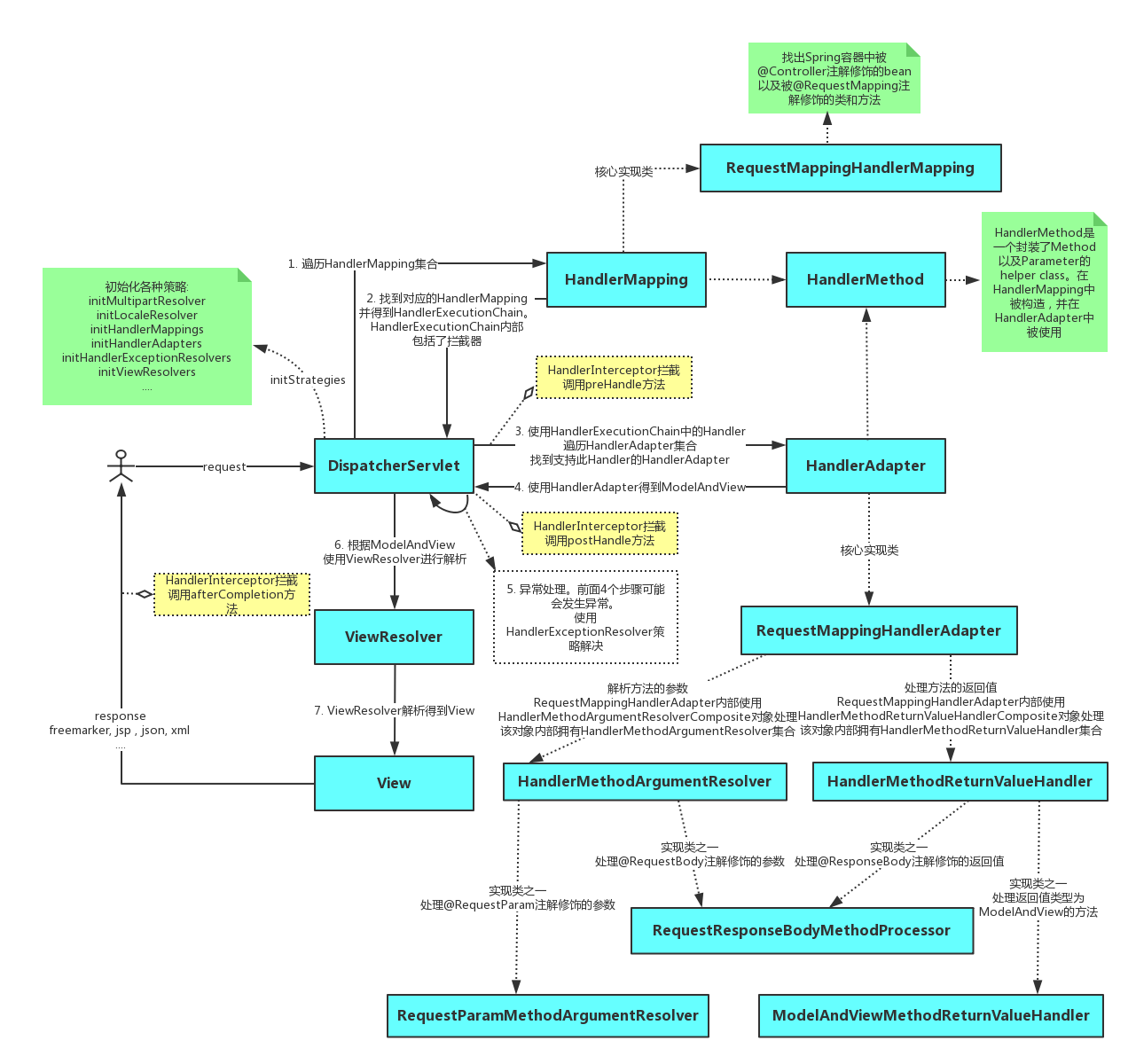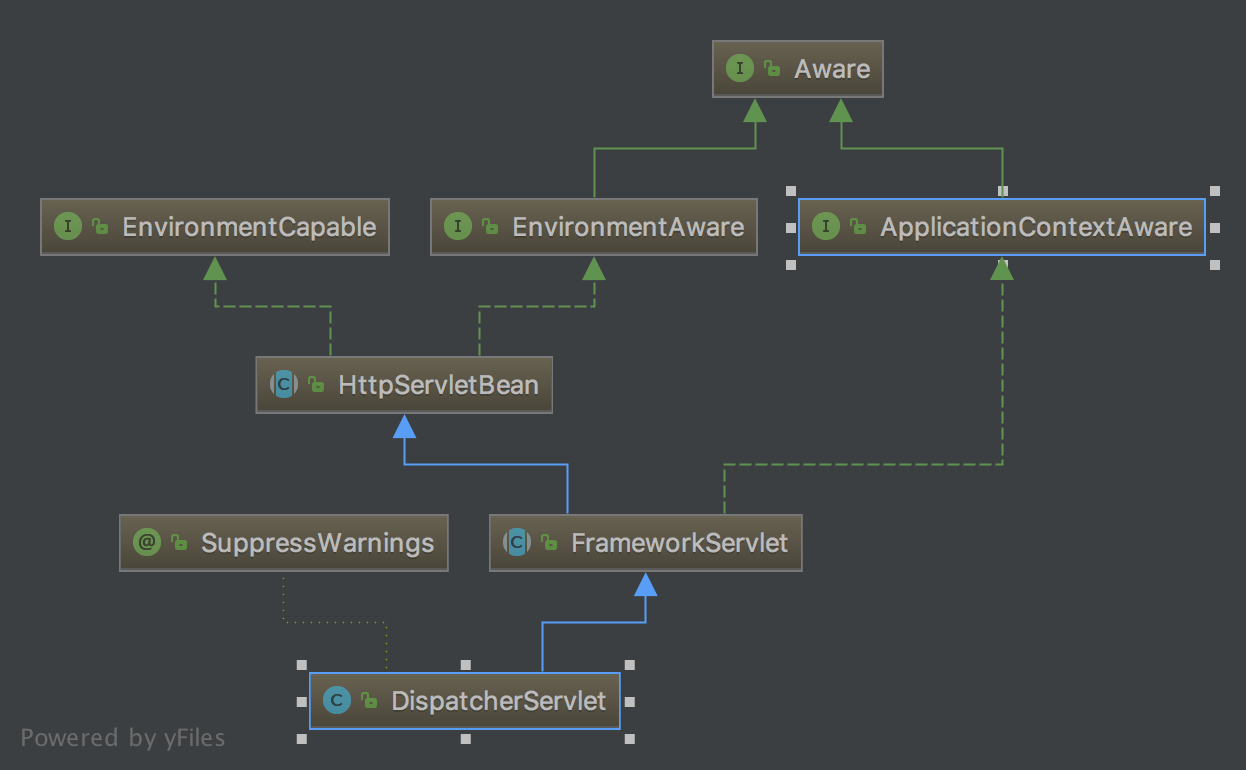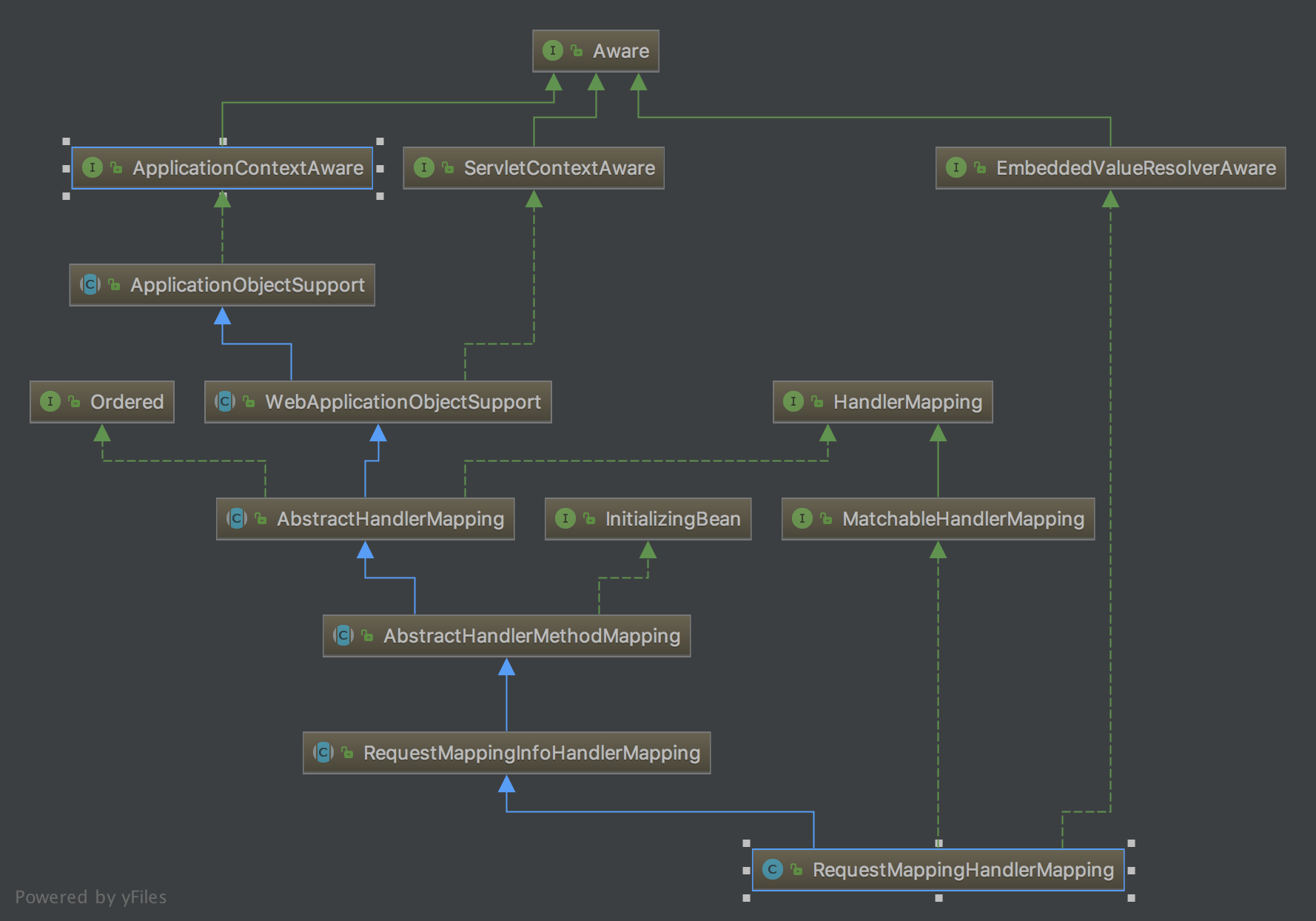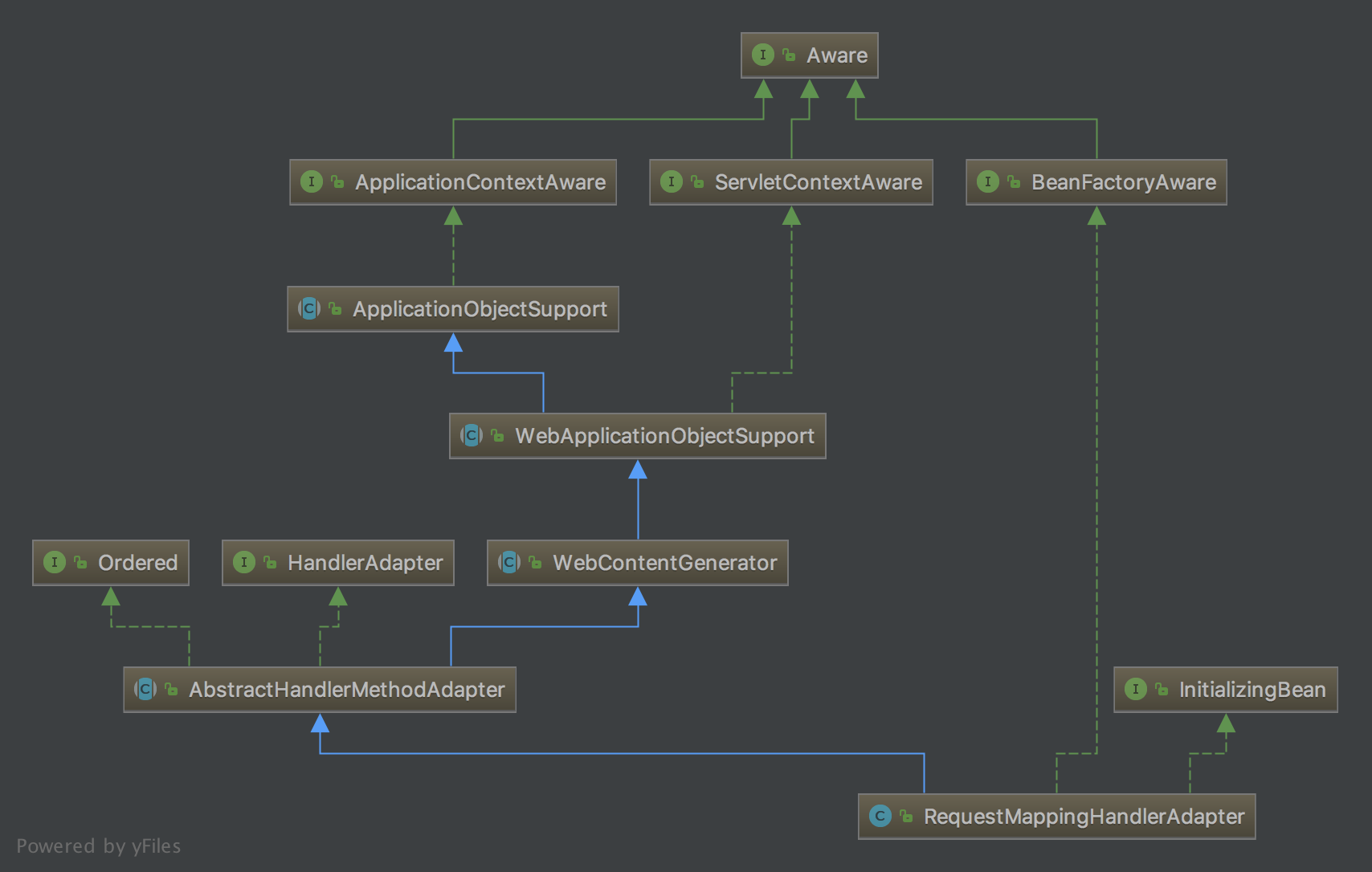1
2
3
4
5
6
7
8
9
10
11
12
13
14
15
16
17
18
19
20
21
22
23
24
25
26
27
28
29
30
31
32
33
34
35
36
37
38
39
40
41
42
43
44
45
46
47
48
49
50
51
52
53
54
55
56
57
58
59
60
61
62
63
64
65
66
67
68
69
70
71
72
73
74
75
76
77
78
79
80
81
82
83
84
85
86
87
88
89
90
91
92
93
94
95
96
97
98
99
100
101
102
103
104
105
106
107
108
109
110
111
112
113
114
115
116
117
118
119
120
121
122
123
124
125
126
127
128
129
130
131
132
133
134
135
136
137
138
139
140
141
142
143
144
145
146
147
148
149
150
151
152
153
154
|
@Override
public BeanDefinition parse(Element element, ParserContext context) {
Object source = context.extractSource(element);
XmlReaderContext readerContext = context.getReaderContext();
CompositeComponentDefinition compDefinition = new CompositeComponentDefinition(element.getTagName(), source);
context.pushContainingComponent(compDefinition);
// ContentNegotiationManagerFactoryBean创建ContentNegotiationManager
RuntimeBeanReference contentNegotiationManager = getContentNegotiationManager(element, source, context);
//1.RequestMappingHandlerMapping
RootBeanDefinition handlerMappingDef = new RootBeanDefinition(RequestMappingHandlerMapping.class);
handlerMappingDef.setSource(source);
handlerMappingDef.setRole(BeanDefinition.ROLE_INFRASTRUCTURE);
handlerMappingDef.getPropertyValues().add("order", 0);
handlerMappingDef.getPropertyValues().add("contentNegotiationManager", contentNegotiationManager);
if (element.hasAttribute("enable-matrix-variables")) {
Boolean enableMatrixVariables = Boolean.valueOf(element.getAttribute("enable-matrix-variables"));
handlerMappingDef.getPropertyValues().add("removeSemicolonContent", !enableMatrixVariables);
}
else if (element.hasAttribute("enableMatrixVariables")) {
Boolean enableMatrixVariables = Boolean.valueOf(element.getAttribute("enableMatrixVariables"));
handlerMappingDef.getPropertyValues().add("removeSemicolonContent", !enableMatrixVariables);
}
configurePathMatchingProperties(handlerMappingDef, element, context);
readerContext.getRegistry().registerBeanDefinition(HANDLER_MAPPING_BEAN_NAME , handlerMappingDef);
//2.跨域CORS配置
RuntimeBeanReference corsRef = MvcNamespaceUtils.registerCorsConfigurations(null, context, source);
handlerMappingDef.getPropertyValues().add("corsConfigurations", corsRef);
//3.ConversionService,默认FormattingConversionServiceFactoryBean
RuntimeBeanReference conversionService = getConversionService(element, source, context);
//4.validator,默认javax.validation.Validator
RuntimeBeanReference validator = getValidator(element, source, context);
//5.messageCodesResolver,配置message-codes-resolver,无返回null
RuntimeBeanReference messageCodesResolver = getMessageCodesResolver(element);
//6.ConfigurableWebBindingInitializer
RootBeanDefinition bindingDef = new RootBeanDefinition(ConfigurableWebBindingInitializer.class);
bindingDef.setSource(source);
bindingDef.setRole(BeanDefinition.ROLE_INFRASTRUCTURE);
bindingDef.getPropertyValues().add("conversionService", conversionService);
bindingDef.getPropertyValues().add("validator", validator);
bindingDef.getPropertyValues().add("messageCodesResolver", messageCodesResolver);
//7.消息转换器
// 默认ByteArrayHttpMessageConverter,StringHttpMessageConverter,
// 加载Jackson的jar包;MappingJackson2XmlHttpMessageConverter,MappingJackson2HttpMessageConverter
ManagedList<?> messageConverters = getMessageConverters(element, source, context);
//8.参数解析器
ManagedList<?> argumentResolvers = getArgumentResolvers(element, context);
//9.返回值处理程序
ManagedList<?> returnValueHandlers = getReturnValueHandlers(element, context);
//10.异步支持,
String asyncTimeout = getAsyncTimeout(element);
RuntimeBeanReference asyncExecutor = getAsyncExecutor(element);
ManagedList<?> callableInterceptors = getCallableInterceptors(element, source, context);
ManagedList<?> deferredResultInterceptors = getDeferredResultInterceptors(element, source, context);
//11.RequestMappingHandlerAdapter
RootBeanDefinition handlerAdapterDef = new RootBeanDefinition(RequestMappingHandlerAdapter.class);
handlerAdapterDef.setSource(source);
handlerAdapterDef.setRole(BeanDefinition.ROLE_INFRASTRUCTURE);
handlerAdapterDef.getPropertyValues().add("contentNegotiationManager", contentNegotiationManager);
handlerAdapterDef.getPropertyValues().add("webBindingInitializer", bindingDef);
handlerAdapterDef.getPropertyValues().add("messageConverters", messageConverters);
addRequestBodyAdvice(handlerAdapterDef);
addResponseBodyAdvice(handlerAdapterDef);
if (element.hasAttribute("ignore-default-model-on-redirect")) {
Boolean ignoreDefaultModel = Boolean.valueOf(element.getAttribute("ignore-default-model-on-redirect"));
handlerAdapterDef.getPropertyValues().add("ignoreDefaultModelOnRedirect", ignoreDefaultModel);
}
else if (element.hasAttribute("ignoreDefaultModelOnRedirect")) {
// "ignoreDefaultModelOnRedirect" spelling is deprecated
Boolean ignoreDefaultModel = Boolean.valueOf(element.getAttribute("ignoreDefaultModelOnRedirect"));
handlerAdapterDef.getPropertyValues().add("ignoreDefaultModelOnRedirect", ignoreDefaultModel);
}
if (argumentResolvers != null) {
handlerAdapterDef.getPropertyValues().add("customArgumentResolvers", argumentResolvers);
}
if (returnValueHandlers != null) {
handlerAdapterDef.getPropertyValues().add("customReturnValueHandlers", returnValueHandlers);
}
if (asyncTimeout != null) {
handlerAdapterDef.getPropertyValues().add("asyncRequestTimeout", asyncTimeout);
}
if (asyncExecutor != null) {
handlerAdapterDef.getPropertyValues().add("taskExecutor", asyncExecutor);
}
handlerAdapterDef.getPropertyValues().add("callableInterceptors", callableInterceptors);
handlerAdapterDef.getPropertyValues().add("deferredResultInterceptors", deferredResultInterceptors);
readerContext.getRegistry().registerBeanDefinition(HANDLER_ADAPTER_BEAN_NAME , handlerAdapterDef);
//12.CompositeUriComponentsContributorFactoryBean创建CompositeUriComponentsContributor
RootBeanDefinition uriContributorDef =
new RootBeanDefinition(CompositeUriComponentsContributorFactoryBean.class);
uriContributorDef.setSource(source);
uriContributorDef.getPropertyValues().addPropertyValue("handlerAdapter", handlerAdapterDef);
uriContributorDef.getPropertyValues().addPropertyValue("conversionService", conversionService);
String uriContributorName = MvcUriComponentsBuilder.MVC_URI_COMPONENTS_CONTRIBUTOR_BEAN_NAME;
readerContext.getRegistry().registerBeanDefinition(uriContributorName, uriContributorDef);
//13.ConversionServiceExposingInterceptor接口,实现ConversionService设置
RootBeanDefinition csInterceptorDef = new RootBeanDefinition(ConversionServiceExposingInterceptor.class);
csInterceptorDef.setSource(source);
csInterceptorDef.getConstructorArgumentValues().addIndexedArgumentValue(0, conversionService);
//13.MappedInterceptor接口,添加ConversionServiceExposingInterceptor接口
RootBeanDefinition mappedInterceptorDef = new RootBeanDefinition(MappedInterceptor.class);
mappedInterceptorDef.setSource(source);
mappedInterceptorDef.setRole(BeanDefinition.ROLE_INFRASTRUCTURE);
mappedInterceptorDef.getConstructorArgumentValues().addIndexedArgumentValue(0, (Object) null);
mappedInterceptorDef.getConstructorArgumentValues().addIndexedArgumentValue(1, csInterceptorDef);
String mappedInterceptorName = readerContext.registerWithGeneratedName(mappedInterceptorDef);
//14.ExceptionHandlerExceptionResolver
RootBeanDefinition methodExceptionResolver = new RootBeanDefinition(ExceptionHandlerExceptionResolver.class);
methodExceptionResolver.setSource(source);
methodExceptionResolver.setRole(BeanDefinition.ROLE_INFRASTRUCTURE);
methodExceptionResolver.getPropertyValues().add("contentNegotiationManager", contentNegotiationManager);
methodExceptionResolver.getPropertyValues().add("messageConverters", messageConverters);
methodExceptionResolver.getPropertyValues().add("order", 0);
addResponseBodyAdvice(methodExceptionResolver);
if (argumentResolvers != null) {
methodExceptionResolver.getPropertyValues().add("customArgumentResolvers", argumentResolvers);
}
if (returnValueHandlers != null) {
methodExceptionResolver.getPropertyValues().add("customReturnValueHandlers", returnValueHandlers);
}
String methodExResolverName = readerContext.registerWithGeneratedName(methodExceptionResolver);
//15.ResponseStatusExceptionResolver
RootBeanDefinition statusExceptionResolver = new RootBeanDefinition(ResponseStatusExceptionResolver.class);
statusExceptionResolver.setSource(source);
statusExceptionResolver.setRole(BeanDefinition.ROLE_INFRASTRUCTURE);
statusExceptionResolver.getPropertyValues().add("order", 1);
String statusExResolverName = readerContext.registerWithGeneratedName(statusExceptionResolver);
//16.DefaultHandlerExceptionResolver
RootBeanDefinition defaultExceptionResolver = new RootBeanDefinition(DefaultHandlerExceptionResolver.class);
defaultExceptionResolver.setSource(source);
defaultExceptionResolver.setRole(BeanDefinition.ROLE_INFRASTRUCTURE);
defaultExceptionResolver.getPropertyValues().add("order", 2);
String defaultExResolverName = readerContext.registerWithGeneratedName(defaultExceptionResolver);
context.registerComponent(new BeanComponentDefinition(handlerMappingDef, HANDLER_MAPPING_BEAN_NAME));
context.registerComponent(new BeanComponentDefinition(handlerAdapterDef, HANDLER_ADAPTER_BEAN_NAME));
context.registerComponent(new BeanComponentDefinition(uriContributorDef, uriContributorName));
context.registerComponent(new BeanComponentDefinition(mappedInterceptorDef, mappedInterceptorName));
context.registerComponent(new BeanComponentDefinition(methodExceptionResolver, methodExResolverName));
context.registerComponent(new BeanComponentDefinition(statusExceptionResolver, statusExResolverName));
context.registerComponent(new BeanComponentDefinition(defaultExceptionResolver, defaultExResolverName));
// Ensure BeanNameUrlHandlerMapping (SPR-8289) and default HandlerAdapters are not "turned off"
MvcNamespaceUtils.registerDefaultComponents(context, source);
context.popAndRegisterContainingComponent();
return null;
}
|





